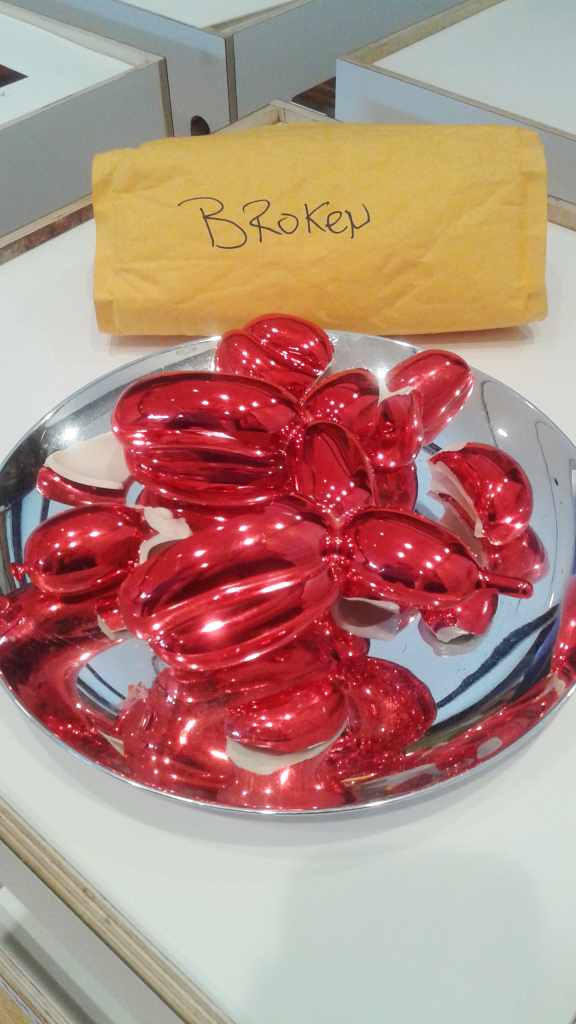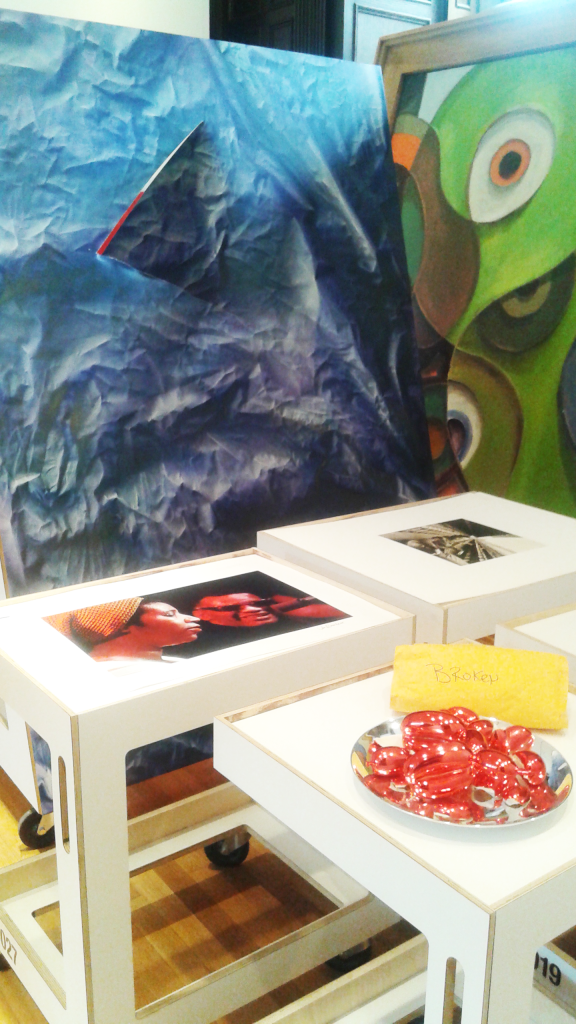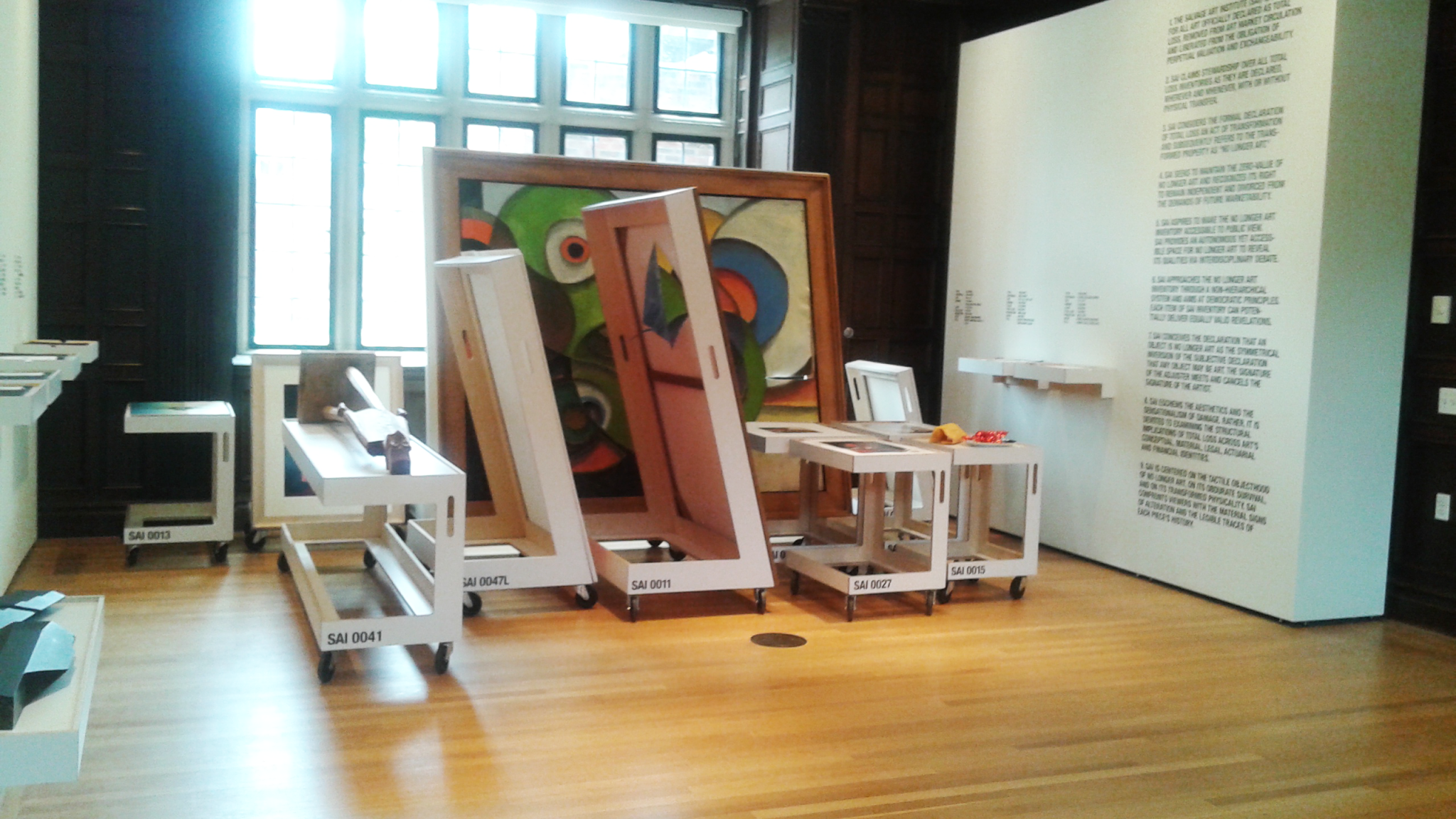Jeff Koons’s Balloon Dog lays shattered in pieces next to a packing sign that matter-of-factly states: “broken.” Its shiny red pieces are now amorphous, unrecognizable as a dog, or even a balloon, for that matter. Similarly, it’s tough not to stare at the gaping rip in Alexandre Dubuisson’s La Moisson, but more difficult to separate the curiosity of the accident from its cost to the original piece. Even more difficult is separating the discussion of artwork, and what its loss means, from this denounced limbo, a second life of sorts, that some pieces inhabit.
“Salvage art” is the art industry and insurance company’s official term for artwork that is removed from circulation after incurring accidental damages, upon which conservators decide recovery efforts are not worth its total market value. Pieces are paid indemnification, deemed devoid of any value, and banished to perpetual storage. Some believe this is the only just way to say goodbye to a broken piece, free of constant re-evaluation and monetary arguments; yet for the most part, these pieces are not exactly shattered—torn and chipped, maybe—but primarily intact. Nevertheless, no matter their former value and perhaps still-intact beauty, these pieces are shelved, literally.
Once an artwork is deemed a “total loss,” the Salvage Art Institute (SAI) steps in. SAI considers this formal declaration of worthlessness the turning point for the artwork, transforming it into “No Longer Art.” SAI doesn’t attempt to sensationalize the wear and tear or place added value on the punctured and worn works—rather, it tries to objectively scrutinize its inventory, separating its former value from its status, or lack thereof, as artwork. Elka Krajewska founded SAI in 2012 to save and support “total loss” art, placing it into a circulation of its own. This concept, and the ensuing conversation, is increasingly relevant, as the art world has lately been inundated with questions about whitewashed graffiti, conservation slipups, and astronomical prices for classics and contemporaries alike. SAI will not be a permanent space, but rather a touring exhibition that allows for even more exposure: a longer afterlife enjoyed than the pieces’ first lives, cut or ripped short.

On first glimpse in the gallery space in the Neubauer Collegium Institute for Culture and Society, on the University of Chicago’s campus, it seems as if the exhibition has not been set up yet and is in the process of being inventoried and mounted. However, this warehouse-esque display is the setup of the pieces, caught in the bittersweet balance between almost mounted and almost thrown out.
The distance between the art and descriptions, titles, and documents such as official insurance documents and email exchanges between artists and galleries creates a living dynamic across the desperately small space. In a way, it’s similar to doing inventory of the quiet warehouse; the pieces feel distant due to their price and fame, yet familiar and almost homey, as pieces seem strewn and pushed together to make way for the little foot room necessary for the space to be enterable.
This is the first art exhibition at the relatively new Neubauer Collegium, and one curator Jacob Proctor felt was fitting for an inaugural project. Proctor explains that they came across the SAI through another ongoing conceptual project on campus, “Material Matters.” Both engage with definitions of space, temporality, and materiality, posing questions that may never have straightforward answers, but which can still lead to rewarding conversations. “From tours with first grade Lab students to conversations with neighborhood residents, we’ve had a good response,” Proctor says. On what people see in the gallery, whether it be trash or art, he says the response differs. “It varies from piece to piece and visitor to visitor. A lot get into forensic play, figuring out how the damage occurs, or even where it is on the piece. Some are of course obvious to spot, and others much more difficult to figure out.”
This moment of finding the minutest impairment—in one piece, a hardly noticeable water stain—is when the real discussion begins. How can an insurance company designate a work a total loss when the artist has designated his object a work of art? Proctor says this discrepancy is the “anti ready-made” version of an object, where the artist and insurance claim lawyer have the same power to make or diminish art.
The walls of the space are barren, listing a quick definition and mission statement and nine no-nonsense “policies.” Policy numbers six, seven, and eight are the most thought-provoking statements, relating to not only the worth but also the ownership and sentimentality of a piece. Number eight states: “SAI eschews the aesthetics and sensationalism of damage.

Rather, it is devoted to examining the structural implications of total loss across art’s conceptual, material, legal, actuarial and financial identities.” Viewers in the gallery space are confronted with damage uncomfortable to the eye of art-lovers yet, for some, irrelevant to the piece itself.
Number seven not only suggests a way of defining art that has been damaged beyond repair, but also makes its readers question the fundamental basis of the entire project: what is art to begin with? How are we to define it, and when does it stop being art? Number seven says, “SAI conceives the declaration that an object is No Longer Art as the symmetrical inversion of the subjective declaration that any object may be art. The signature of the adjuster meets and cancels the signature of the artist.”
Perhaps most importantly, SAI’s sixth policy states, “SAI approaches the No Longer Art inventory through a non-hierarchical system and aims at democratic principles. Each item of SAI inventory can potentially deliver equally valid revelations.”
Above all else, SAI forces its viewers to actively develop questions and opinions on the definition of art and its implications. Their gallery asks viewers to embody the same qualities in the form of open-minded thoughtfulness in order to truly take away something from the walk through works of art that are busted up and beat down, yet still intrinsically beautiful.

